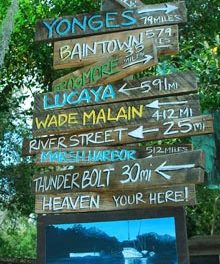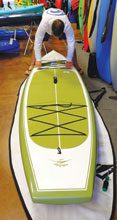 The Backyard Tourist Takes a Photo Safari of Ted Turner’s Former SC Retreat
The Backyard Tourist Takes a Photo Safari of Ted Turner’s Former SC Retreat
Story and Photos by Mark Shaffer
(Editor’s Note: Read part one of Mark Shaffer’s conversation with Park Superintendent J.W. Weatherford about the challenges of overseeing both Hunting Island and St. Phillips here.)
“Welcome, to Jurassic Park.”
That’s the line that comes to mind each time JW Weatherford sets foot on St. Phillips Island, South Carolina’s unique new addition to the state park system. It’s easy to see why. The island is isolated and accessible only by boat. With the exception of a caretaker’s residence, it is virtually uninhabited by man. The island’s only road snakes through four miles of dense h abitat along the tops of ancient dunes. It’s easy to imagine a T-Rex stepping into the path or a pack of velociraptors stalking through the saw palmetto carpeting the floor of the maritime forest.
abitat along the tops of ancient dunes. It’s easy to imagine a T-Rex stepping into the path or a pack of velociraptors stalking through the saw palmetto carpeting the floor of the maritime forest.
Luckily for those fortunate enough to tour the park system’s lone National Natural Landmark, the only raptors around are the local, winged variety. And they are impressive. Indeed, the island’s uniquely diverse ecosystem, and abundance of fresh water, makes for a profusion of wildlife.
In mid November park rangers ran the first four public tours of the island. These initial “shakedown cruises” were limited to 16 individuals and will help form a management plan for the park. I was fortunate enough to ride along on the final tour. The day begins by signing in at the Hunting Island Nature Center before splitting up into two boats for the five-mile ride to the St. Phillips docks. Our tour guides include Hunting Island Naturalist, Megan Stegmeir, and Terry Conway, 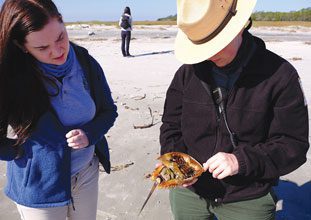 Coastal Region Interpreter, based out of Charles Towne Landing. Together they provide a wealth of insight and information about the natural and historic aspects of the island. The tides dictate the schedule. So, we begin on the beach. Some follow the rangers about for impromptu field lessons. Some of us simply use the generous amount of time to wonder the sand with our cameras and binoculars, picking up shells and shards of Native American pottery, stumbling over sea-worn chunks of ancient tabby.
Coastal Region Interpreter, based out of Charles Towne Landing. Together they provide a wealth of insight and information about the natural and historic aspects of the island. The tides dictate the schedule. So, we begin on the beach. Some follow the rangers about for impromptu field lessons. Some of us simply use the generous amount of time to wonder the sand with our cameras and binoculars, picking up shells and shards of Native American pottery, stumbling over sea-worn chunks of ancient tabby.
Lunch is served on the screened-in porch of the Turner house, a sprawling 3300 square foot home facing the ocean that will likely be available for weekly rental once park officials have refined their plans. A pair of bottlenose dolphin cruise past the pier and seawall as we eat.
The rest of the day is spent touring the interior trails, meandering through the maritime forest,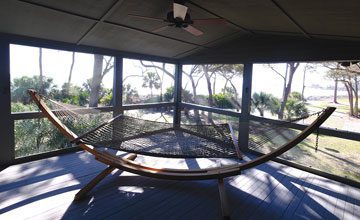 learning about the natural wonders that abound on the island, which include some of the most magnificent trees to be found along the coast. On the boat ride back to Hunting Island everyone is lost in thought, perhaps overwhelmed by a rare glimpse at one of the last best places around.
learning about the natural wonders that abound on the island, which include some of the most magnificent trees to be found along the coast. On the boat ride back to Hunting Island everyone is lost in thought, perhaps overwhelmed by a rare glimpse at one of the last best places around.
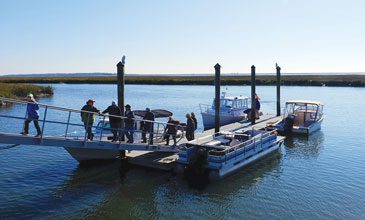 Loading in at the dock
Loading in at the dock
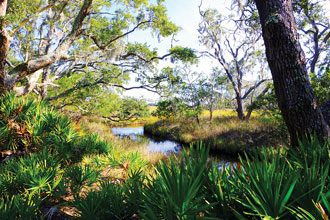 Its habit diversity makes St. Phillips unique among the sea islands
Its habit diversity makes St. Phillips unique among the sea islands
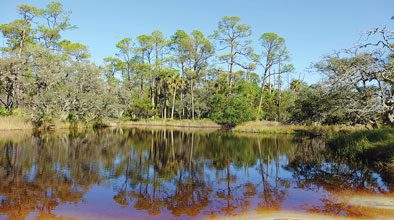 The beach meets the wetlands
The beach meets the wetlands
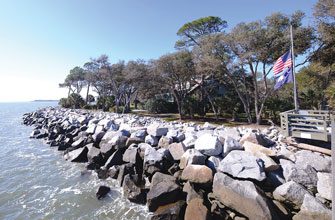 A glimpse of Ted Turner’s house on St. Phillips
A glimpse of Ted Turner’s house on St. Phillips
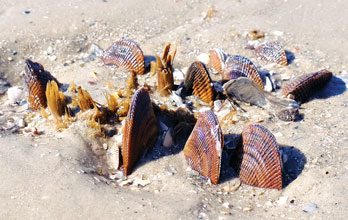 A reason to wear shoes on St. Phillips
A reason to wear shoes on St. Phillips
 St. Phillips’ interior wetlands are perfect hideaways for alligators.
St. Phillips’ interior wetlands are perfect hideaways for alligators.
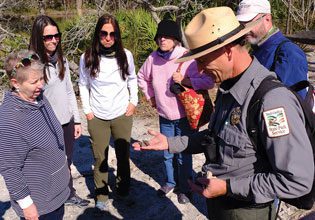 Coastal Region interpreter Terry Conway explains Native American artifacts found on St. Phillips.
Coastal Region interpreter Terry Conway explains Native American artifacts found on St. Phillips.
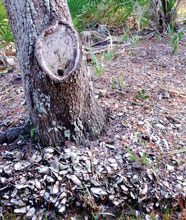 Oyster hummocks mark ancient feast by Native Americans on St. Phillips.
Oyster hummocks mark ancient feast by Native Americans on St. Phillips.
 The abundant food supply makes St. Phillips a birder’s paradise.
The abundant food supply makes St. Phillips a birder’s paradise.
 A roseate spoonbill on St. Phillips Island.
A roseate spoonbill on St. Phillips Island.
The Backyard Tourist’s Exclusive Video Tours and Interviews on St. Phillips Island
Beach Panorama: https://www.youtube.com/watch?v=QscNYIJL7nY
Naturalist Megan Stegmeir: https://www.youtube.com/watch?v=HwZVimUCNTg&t=9s
Park Superintendent JW Weatherford: https://www.youtube.com/watch?v=iVFgzzo6re8&t=15s
Public tours of St. Phillips Island will resume in Spring 2019.


